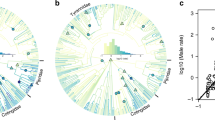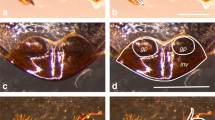Abstract
The rate of evolutionary morphological change in secondary sexual characters among species has traditionally been assumed to exceed that for non-sexual characters, giving rise to a larger degree of divergence. We used a large data set of independent evolutionary events of exaggerated secondary sexual feather characters across all birds to test whether that was the case. Comparative analyses revealed that secondary sexual tail feather characters diverged more than wing feathers in females, and we also found that secondary sexual head feather characters diverged more than tarsi in males, when only including intra-order comparisons in the analyses. These results are in the predicted direction, with secondary sexual characters diverging more than ordinary morphological traits, partially supporting the general impression that secondary sexual characters are more variable among species than ordinary morphological characters. However, the degree of divergence among secondary sexual characters was generally not much larger than that among ordinary characters. Some non-significant differences in divergence between secondary sexual characters and ordinary characters could be explained by the cost-reducing function of ordinary morphological traits. There was no evidence of significant differences in divergence between sexes for secondary sexual characters, maybe because of genetic correlations in morphology between the sexes. However, male tarsi diverged more than female tarsi, and sexual selection might play a role in this difference in divergence.
Similar content being viewed by others
References
Alatalo, R.V., Höglund, J. and Lundberg, A. (1988) Patterns of variation in tail ornament size in birds. Biol. J. Linn. Soc. 34, 363–374.
Andersson, M. (1994) Sexual Selection. Princeton University Press, Princeton, NJ.
Balmford, A., Jones, I.L. and Thomas, A.L.R. (1994) How to compensate for costly sexually selected tails: the origin of sexually dimorphic wings in long-tailed birds. Evolution 48, 1062–1070.
Barraclough, T.G., Harvey, P.H. and Nee, S. (1995) Sexual selection and taxonomic diversity in passerine birds. Proc. R. Soc. Land. B 259, 211–215.
Becker, W.A. (1984) Manual of Quantitative Genetics, 4th edn. Academic Enterprises, Pullman, WA.
Brown, W.L., Jr. and Wilson, E.O. (1956) Character displacement. Syst. Zool. 5, 49–64.
Burns, K. J. (1998) A phylogenetic perspective on the evolution of sexual dichromatism in tanagers (Thraupidae): the role of female versus male plumage. Evolution 52, 1219–1224.
Chandler, C.R. (1995) Practical considerations in the use of simultaneous inference for multiple tests. Anim. Behav. 49, 524–527.
Clutton-Brock, T.H. (1985) Size, sexual dimorphism, and polygyny in primates. In W.L. Junger (ed.) Size and Scaling in Primate Biology. Plenum Press, New York, NY, pp. 51–60.
Clutton-Brock, T.H., Harvey, P.H. and Rudder, B. (1977) Sexual dimorphism, socionomic sex ratio, and body weight in primates. Nature 269, 797–799.
Clutton-Brock, T.H., Albon, S.D. and Harvey, P.H. (1980) Antlers, body size, and breeding group size in the Cervidae. Nature 285, 565–567.
Cohen, J. (1988) Statistical Power Analysis for the Behavioral Sciences, 2nd edn. Lawrence Erlbaum, Hillsdale, NJ.
Coyne, J.L. (1992) Genetics and speciation. Nature 355, 511–515.
Coyne, J.A. and Orr, H.A. (1989) Patterns of speciation in Drosophila. Evolution 43, 362–381.
Cuervo, J.J. and Møller, A.P. (1999) Phenotypic variation and fluctuating asymmetry in sexually dimorphic feather ornaments in relation to sex and mating system. Biol. J. Linn. Soc. 68, 505–529.
Cuervo, J.J. and Møller, A.P. (2000) Sex limited expression of ornamental feathers in birds. Behav. Ecol. 11 (in press).
Darwin, C. (1871) The Descent of Man, and Selection in Relation to Sex. John Murray, London, UK.
Dobzhansky, T. (1940) Speciation as a stage in evolutionary divergence. Am. Nat. 74, 312–332.
Endler, J.A. (1989) Conceptual and other problems in speciation. In D. Otte and J.A. Endler (eds) Speciation and its Consequences. Sinauer, Sunderland, MA, pp. 626–648.
Falconer, D.S. (1989) Introduction to Quantitative Genetics, 3rd edn. Longman, New York, NY.
Felsenstein, J. (1985) Phylogenies and the comparative method. Am. Nat. 125, 1–15.
Felsenstein, J. (1988) Phylogenies and quantitative methods. Ann. Rev. Ecol. Syst. 19, 445–471.
Fisher, R.A. (1930) The Genetical Theory of Natural Selection. Clarendon Press, Oxford, UK.
Garland, T., Jr. (1992) Rate tests for phenotypic evolution using phylogenetically independent contrasts. Am. Nat. 140, 509–519.
Garland, T., Jr., Harvey, P.H. and Ives, A.R. (1992) Procedures for the analysis of comparative data using phylogenetically independent contrasts. Syst. Biol. 41, 18–32.
Garland, T., Jr., Dickerman, A.W., Janis, C.M. and Jones, J.A. (1993) Phylogenetic analysis of covariance by computer simulation. Syst. Biol. 42, 265–292.
Gingerich, P.D. (1993) Quantification and comparison of evolutionary rates. Am. J. Sci. 293-A, 453–478.
Gittleman, J.L., Anderson, C.G., Kot, M. and Luh, H.-K. (1996) Phylogenetic lability and rates of evolution: a comparison of behavioral, morphological and life history traits. In E.P. Martins (ed.) Phylogenies and the Comparative Method in Animal Behavior. Oxford University Press, New York, NY, pp. 166–205.
Grafen, A. (1989) The phylogenetic regression. Phil. Trans. R. Soc. Land. B 326, 119–156.
Heard, S.B. and Hauser, D.L. (1994) Key evolutionary innovations and their ecological mechanisms. Hist. Biol. 10, 151–173.
Hill, G.E. (1993) Male mate choice and the evolution of female coloration in the house finch. Evolution 47, 1515–1525.
Höglund, J. (1989) Size and plumage dimorphism in lek-breeding birds: a comparative analysis. Am. Nat. 134, 72–87.
Höglund, J. and Sillén-Tullberg, B. (1994) Does lekking promote the evolution of male-biased size dimorphism in birds? On the use of comparative approaches. Am. Nat. 144, 881–889.
Irwin, R.E. (1994) The evolution of plumage dichromatism in the New World blackbirds: social selection on female brightness? Am. Nat. 144, 890–907.
Johnson, K. (1988) Sexual selection in pinyon jays. II. Male choice and female-female competition. Anim. Behav. 36, 1048–1053.
Jones, I.L. and Hunter, F.M. (1993) Mutual sexual selection in a monogamous seabird. Nature 362, 238–239.
Kaneshiro, K.Y. (1980) Sexual aisolation, speciation and the direction of evolution. Evolution 34, 437–444.
Kaneshiro, K.Y. and Boake, C.R.B. (1987) Sexual selection and speciation. Trends Ecol. Evol. 2, 207–212.
Lambert, D.M. and Spencer, H.G. (eds) (1995) Speciation and the Recognition Concept. Johns Hopkins, Baltimore, MD.
Lande, R. (1980) Sexual dimorphism, sexual selection, and adaptation in polygenic characters. Evolution 34, 292–307.
Lande, R. (1981) Models of speciation by sexual selection on polygenic traits. Proc. Natl. Acad. Sci. USA 78, 3721–3725.
Lande, R. and Arnold, S. J. (1985) Evolution of mating preference and sexual dimorphism. J. Theor. Biol. 117, 651–664.
Martin, T.E. and Badyaev, A.V. (1996) Sexual dichromatism in birds: importance of nest predation and nest location for females versus males. Evolution 50, 2454–2460.
Martins, E.P. (1994) Estimating the rate of phenotypic evolution from comparative data. Am. Nat. 144, 193–209.
Martins, E.P. and Garland, T.G., Jr. (1991) Phylogenetic analyses of the correlated evolution of continuous characters: a simulation study. Evolution 45, 534–557.
Mayr, E. (1963) Animal Species and Evolution. Harvard University Press, Cambridge, MA.
McLain, D.K. (1993) Copes's rules, sexual selection, and the loss of ecological plasticity. Oikos 68, 490–500.
Mitra, S., Landel, H. and Pruett-Jones, S. (1996) Species richness covaries with mating system in birds. Auk 113, 544–551.
Møller, A.P. (1994) Sexual Selection and the Bam Swallow. Oxford University Press, Oxford, UK.
Møller, A.P. (1996) The cost of secondary sexual characters and the evolution of cost-reducing traits. Ibis 138, 112–119.
Møller, A.P. and Cuervo, J.J. (1998) Speciation and feather ornamentation in birds. Evolution 52, 859–869.
Oakes, E.J. (1992) Lekking and the evolution of sexual dimorphism in birds: comparative approaches. Am. Nat. 140, 665–684.
Otte, D. and Endler, J.A. (1989) Speciation and its Consequences. Sinauer, Sunderland, MA.
Paterson, H.E.H. (1978) More evidence against speciation by reinforcement. S. Afr. J. Sci. 74, 369–371.
Paterson, H.E.H. (1985) The recognition concept of species. In E.S. Vrba (ed.) Species and Speciation. Transvaal Museum, Pretoria, South Africa, pp. 21–29.
Pomiankowski, A. and Møller, A.P. (1995) A resolution of the lek paradox. Proc. R. Soc. Land. B 260, 21–29.
Price, T. (1998) Sexual selection and natural selection in bird speciation. Phil. Trans. R. Soc. Land. B 353, 251–260.
Price, T. and Birch, G.L. (1996) Repeated evolution of sexual color dimorphism in passerine birds. Auk 113, 842–848.
Purvis, A., Gittleman, J.L. and Luh, H.-K. (1994) Truth or consequences: effects of phylogenetic accuracy on two comparative methods. J. Theor. Biol. 167, 293–300.
Purvis, A. and Rambaut, A. (1995) Comparative analysis by independent contrasts (CAIC): an Apple Macintosh application for analysing comparative data. Comput. Appl. Biosci. 11, 247–251.
Rice, W.R. (1989) Analyzing tables of statistical tests. Evolution 43, 223–225.
Rice, W.R. and Hostert, E.E. (1993) Laboratory experiments on speciation: What have we learned in 40 years? Evolution 47, 1637–1653.
Ryan, M.J. and Rand, A.S. (1993) Species recognition and sexual selection as a unitary problem in animal communication. Evolution 47, 647–657.
Schluter, D. and Price, T. (1993) Honesty, perception and population divergence in sexually selected traits. Proc. R. Soc. Land. B 253, 117–122.
Selander, R.K. (1966) Sexual dimorphism and differential niche utilization in birds. Condor 68, 113–151.
Sheldon, F.H. and Winkler, D.W. (1993) Intergeneric phylogenetic relationships of swallows estimated by DNA-DNA hybridization. Auk 110, 798–824.
Sibley, C.G. and Ahlquist, J.E. (1990) Phylogeny and Classification of Birds. Yale University Press, New Haven, CT.
Sokal, R.R. and Rohlf, F.J. (1995) Biometry, 3rd edn. Freeman, San Francisco, CA.
Svensson, L. (1984) Identification Guide to European Passerines, 2nd edn. L. Svensson, Stockholm, Sweden.
Templeton, A.R. (1981) Mechanisms of speciation — a population genetic approach. Annu. Rev. Ecol. Syst. 12, 23–48.
Templeton, A.R. (1989) The meaning of species and speciation. In D. Otte and J.A. Endler (eds) Speciation and its consequences. Sinauer, Sunderland, MA, pp. 3–27.
Thornhill, R. and Alcock, J. (1983) The Evolution of Insect Mating Systems. Harvard University Press, Cambridge, MA.
West-Eberhard, M.J. (1983) Sexual selection, social competition, and speciation. Q. Rev. Biol. 58, 155–183.
West-Eberhard, M.J. (1984) Sexual selection, competitive communication and species-specific signals in insects. In T. Lewis (ed.) Insect communication. Academic Press, New York, NY, pp. 283–324.
Wright, S.P. (1992) Adjusted p-values and simultaneous inference. Biometrics 48, 1005–1013.
Author information
Authors and Affiliations
Rights and permissions
About this article
Cite this article
Cuervo, J.J., Møller, A.P. Evolutionary rates of secondary sexual and non-sexual characters among birds. Evolutionary Ecology 13, 283–303 (1999). https://doi.org/10.1023/A:1006733405877
Issue Date:
DOI: https://doi.org/10.1023/A:1006733405877




